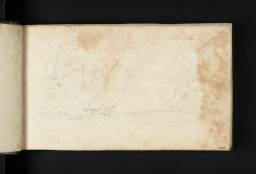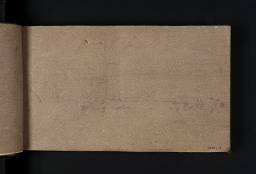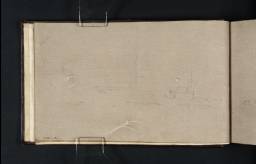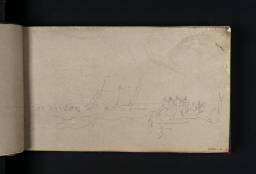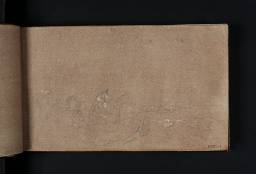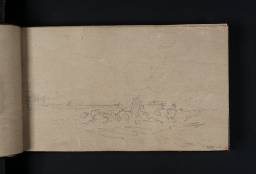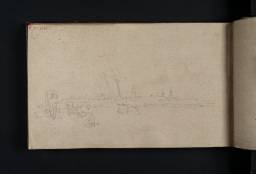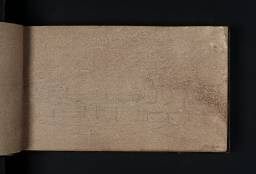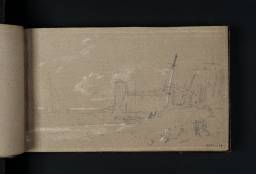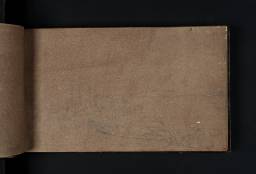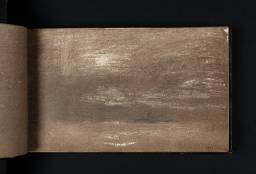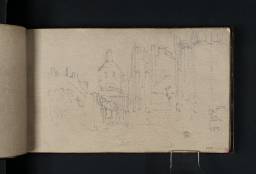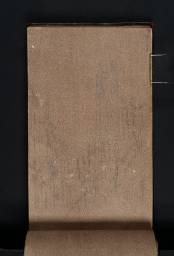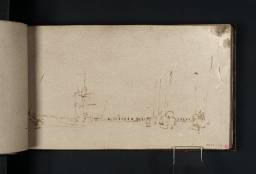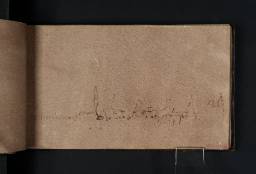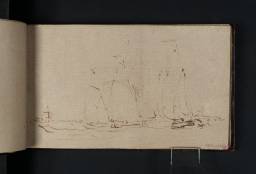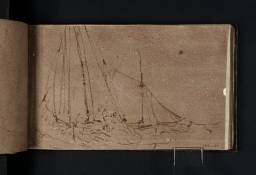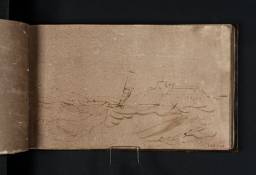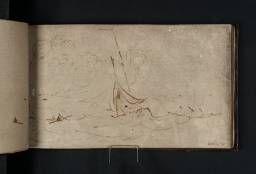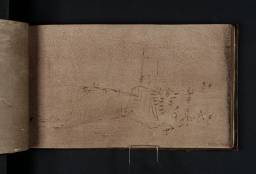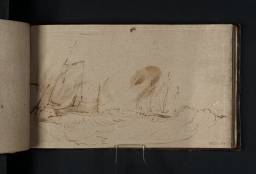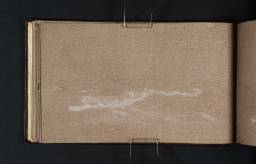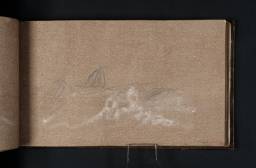Turner Bequest LXXI
Sketchbook bound in calf, with gold-tooled borders and ribbed spine, the brass clasp now missing
78 leaves, 74 of white wove Whatman paper made on a double-faced mould, washed with grey wash on one side and a sooty reddish brown on the other, and 4 flyleaves of white laid paper Approximate page size 112 x 187 mm
Probably made up by William Dickie. The wove paper made by William Balston and the brothers Finch and Thomas Robert Hollingworth, Turkey Mill, Maidstone, Kent, and watermarked ‘1794 | J WHATMAN’
Inscribed in ink ‘Ca’ [?lais] on front cover
Numbered ‘328’ as part of the Turner Schedule, and endorsed by the Executors of the Turner Bequest ‘Contains 35 leaves – Pencel [sic] & chalk Sketches’. Signed by Charles Turner in ink ‘C Turner’ and by John Prescott Knight ‘JPK’ and by Charles Lock Eastlake ‘C.L.E’. inside back cover. Inscribed by John Ruskin in ink on a label inside front cover ‘328. | Calais Pier | Original sketches in it | cut out | (out of A.B. 195 P, in Box A) JR. 1878’. Also inscribed by Arthur Mayger Hind in pencil ‘Loose leaves | described in Inv. A | 66 – 72 replaced in original | order | AMH 1934’ inside front cover
78 leaves, 74 of white wove Whatman paper made on a double-faced mould, washed with grey wash on one side and a sooty reddish brown on the other, and 4 flyleaves of white laid paper Approximate page size 112 x 187 mm
Probably made up by William Dickie. The wove paper made by William Balston and the brothers Finch and Thomas Robert Hollingworth, Turkey Mill, Maidstone, Kent, and watermarked ‘1794 | J WHATMAN’
Inscribed in ink ‘Ca’ [?lais] on front cover
Numbered ‘328’ as part of the Turner Schedule, and endorsed by the Executors of the Turner Bequest ‘Contains 35 leaves – Pencel [sic] & chalk Sketches’. Signed by Charles Turner in ink ‘C Turner’ and by John Prescott Knight ‘JPK’ and by Charles Lock Eastlake ‘C.L.E’. inside back cover. Inscribed by John Ruskin in ink on a label inside front cover ‘328. | Calais Pier | Original sketches in it | cut out | (out of A.B. 195 P, in Box A) JR. 1878’. Also inscribed by Arthur Mayger Hind in pencil ‘Loose leaves | described in Inv. A | 66 – 72 replaced in original | order | AMH 1934’ inside front cover
Exhibition history
References
This sketchbook was used during Turner’s first continental tour in 1802 (see Introduction, Sketchbooks from the Tour to Switzerland 1802). He brought it with him from England, and used it on his Channel crossing, the first time off Dover, then mainly around Calais and a little on his way on to Paris and in the capital.
The book is one of three which Turner had bound in calf before his departure; see also his Studies in the Louvre and St Gothard and Mont Blanc sketchbooks (Tate D04275–D04390; Turner Bequest LXII and Tate D04590–D04648; D41390–D41381; Turner Bequest LXXV). Turner prepared the leaves with coloured washes before binding, doubtless to form a suitable ground for studies in pen and ink and involving tones and highlights, for example in chalk or gouache or raised by stopping out with a damp cloth. The sketchbook contains a few studies of this kind. Although Turner may have begun them outdoors, as events and scenery unfolded, he must have worked them up later. However, he found himself using the book mainly for quick notations made on the spot. Most of the sketches are in pencil and quite rudimentary, while some are now difficult to make out. As usual, Turner turned the book to different angles, and sometimes spread his drawings across a double page.
Having sailed from Dover on the morning of Thursday 15 July 1802, Turner arrived off Calais the same evening. Rough conditions and the tide obliged his boat to weigh anchor, and Turner and some other passengers transferred to a smaller boat which rowed out to meet them, finally wading ashore on the beach through rolling breakers. He recorded the wet and difficult landing in detail in his larger Calais Pier sketchbook (Tate D04902–D05072; Turner Bequest LXXXI), working from memory and composing dramatic ideas for pictures. The present sketchbook contains more immediate impressions. Turner used it to record hasty memoranda of the pier, harbour and town; some were made while waiting to land, others from the shore. Some sketches are too perfunctory or generalised to require individual comment. Others, though slight, already form effective compositions and subsequently contributed with the larger sketchbook to at least two pictures, Calais Pier, with French Poissards Preparing for Sea: an English Packet Arriving, shown at the Royal Academy the following spring (National Gallery, London)1 and Fishing Boats Entering Calais Harbour of about the same date (Frick Collection, New York);2 see for example the second flyleaf (D04191) for the first of these and folio1 (D04192) for the second. Turner also added a few views of the towns and country on the way – via Abbeville and Amiens – to Paris, where he brought out the sketchbook for some first impressions on pictures in the Louvre, in addition to those in his book of studies in the museum and the single copy in his France, Savoy, Piedmont sketchbook (Tate D04394; Turner Bequest LXXIII 2).
Technical notes
How to cite
David Blayney Brown, ‘Small Calais Pier sketchbook 1802’, sketchbook, April 2003, in David Blayney Brown (ed.), J.M.W. Turner: Sketchbooks, Drawings and Watercolours, Tate Research Publication, December 2012, https://www


